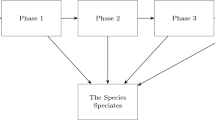Abstract
The Yule model is a widely used speciation model in evolutionary biology. Despite its simplicity many aspects of the Yule model have not been explored mathematically. In this paper, we formalise two analytic approaches for obtaining probability densities of individual branch lengths of phylogenetic trees generated by the Yule model. These methods are flexible and permit various aspects of the trees produced by Yule models to be investigated. One of our methods is applicable to a broader class of evolutionary processes, namely the Bellman–Harris models. Our methods have many practical applications including biodiversity and conservation related problems. In this setting the methods can be used to characterise the expected rate of biodiversity loss for Yule trees, as well as the expected gain of including the phylogeny in conservation management. We briefly explore these applications.
Similar content being viewed by others
References
Aldous D.J.: Stochastic models and descriptive statistics for phylogenetic trees, from Yule to today. Stat. Sci. 16(1), 23–34 (2001)
Blum M., Francois O.: Which random processes describe the Tree of Life? A large-scale study of phylogenetic tree imbalance. Syst. Biol. 55(4), 685–691 (2006)
Crozier R.H.: Preserving the information content of species: Genetic diversity, phylogeny, and conservation worth. Annu. Rev. Ecol. Syst. 28, 243–268 (1997)
Crump K.S., Mode C.J.: A general age-dependent branching process I. J. Math. Anal. Appl. 24, 494–508 (1968)
Crump K.S., Mode C.J.: A general age-dependent branching process II. J. Math. Anal. Appl. 25, 8–17 (1969)
Faith D.P.: Conservation evaluation and phylogenetic diversity. Biol. Conserv. 61, 1–10 (1992)
Gernhard, T.: Stochastic models of speciation events in phylogenetic trees. Diplom Thesis, Technical University of Munich, Germany (2006)
Gernhard, T.: The conditioned reconstructed process. J. Theor. Biol. (2008, in press)
Gernhard T., Ford D., Vos R., Steel M.: Estimating the relative order of speciation or coalescence events on a given phylogeny. Evol. Bioinform. Online 2, 309–317 (2006)
Harding E.F.: The probabilities of rooted tree-shapes generated by random bifurcation. Adv. Appl. Probab. 3, 44–47 (1971)
Hartmann, K., Mooers, A.O.: When should phylogenies guide conservation management? (in preparation)
Hartmann K., Steel M.: Phylogenetic diversity: from combinatorics to ecology. In: Gascuel, O., Steel, M.(eds) Reconstructing Evolution—New Mathematical and Computational Advances, Oxford University Press, New York (2007)
Hartmann, K., Gernhard, T., Wong, D.: Sampling trees from evolutionary models. Systematic Biology (submitted)
Jagers P.: Branching processes with biological applications. Wiley, New York (1975)
McKenzie A., Steel M.: Distributions of cherries for two models of trees. Math. Biosci. 164(1), 81–92 (2000)
Mooers A.Ø., Heard S.B.: Inferring evolutionary process from phylogenetic tree shape. Q. Rev. Biol. 72(1), 31–54 (1997)
Mooers A.O., Heard S.B., Chrostowski E.: Evolutionary heritage as a metric for conservation. In: Purvis, A., Brooks, T., Gittleman, J.(eds) Phylogeny and Conservation, pp. 120–138. Cambridge University Press, Cambridge (2005)
Nee S., May R.M.: Extinction and the loss of evolutionary history. Science 278(5338), 692–694 (1997)
Redding D., Hartmann K., Mimoto A., Bokal D., DeVos M., Mooers A.O.: The most “original species” often capture more phylogenetic diversity than expected. J. Theor. Biology, in press 251, 606–615 (2008)
Sankaranarayanan G.: Branching Processes and its Estimation Theory. Wiley, New York (1989)
Semple C., Steel M.: Phylogenetics. Oxford University Press, New York (2003)
Steel M.: Tools to construct and study big trees: A mathematical perspective. In: Hodkinson T.R., Parnell J.A. (eds.) Reconstructing the Tree of Life: Taxonomy and Systematics of Species Rich Taxa. CRC Press, USA (2006)
Steel M., McKenzie A.: Properties of phylogenetic trees generated by Yule-type speciation models. Math. Biosci. 170, 91–112 (2001)
Walters C.J.: Adaptive Management of Renewable Resources. Macmillan, New York (1986)
Yule G.U.: A mathematical theory of evolution, based on the conclusions of Dr. J.C. Wllis, F.R.S. Philos. Trans. R. Soc. Lond. Ser. B 213, 21–87 (1924)
Author information
Authors and Affiliations
Corresponding author
Additional information
T. Gernhard and K. Hartmann contributed equally.
Rights and permissions
About this article
Cite this article
Gernhard, T., Hartmann, K. & Steel, M. Stochastic properties of generalised Yule models, with biodiversity applications. J. Math. Biol. 57, 713–735 (2008). https://doi.org/10.1007/s00285-008-0186-y
Received:
Revised:
Published:
Issue Date:
DOI: https://doi.org/10.1007/s00285-008-0186-y




